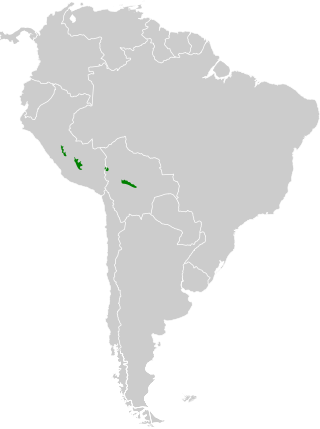
The wire-crested thorntail is a hummingbird in the "coquettes", tribe Lesbiini of subfamily Lesbiinae. It is found in humid forests in the Andean foothills of Colombia, Ecuador, Peru, and possibly Bolivia.

The purple-crowned fairy is a species of hummingbird in the subfamily Polytminae, the mangoes. It is found from southeastern Mexico south into northern Peru.

The needle-billed hermit is a species of hummingbird in the family Trochilidae. It is found in Bolivia, Brazil, and Peru.

The speckled chachalaca is a species of bird in the family Cracidae, the chachalacas, guans, and curassows. It is found in Bolivia, Brazil, Colombia, Ecuador, and Peru.

Chapman's swift is a species of bird in subfamily Apodinae of the swift family Apodidae. It is found in Bolivia, Brazil, Colombia, French Guiana, Guyana, Panama, Peru, Suriname, Trinidad, Venezuela, and possibly Ecuador.

The semicollared puffbird is a species of near-passerine bird in the family Bucconidae, the puffbirds, nunlets, and nunbirds. It is one of seven species of the genus Malacoptila. It is found in Bolivia, Brazil, and Peru.

The brown nunlet is a species of near-passerine bird in the family Bucconidae, the puffbirds, nunlets, and nunbirds. It is found in Colombia, Ecuador, and Peru.

The white-necked puffbird is a species of bird in the family Bucconidae, the puffbirds, nunlets, and nunbirds. It is found in Mexico, Central America, Bolivia, Brazil, Colombia, Ecuador, Peru, and Venezuela.

The brown-banded puffbird is a species of bird in the family Bucconidae, the puffbirds, nunlets, and nunbirds. It is found in Bolivia, Brazil, Colombia, Peru, and Venezuela.

The blackish nightjar is a species of bird in the family Caprimulgidae. It is found in Brazil, Bolivia, Colombia, Ecuador, French Guiana, Guyana, Peru, Suriname, and Venezuela.

The cloud-forest screech owl is a species of owl in the family Strigidae. It is found in Bolivia and Peru.

The long-tailed potoo is a species of bird in the family Nyctibiidae. It is found in every mainland South American country except Chile and Uruguay.

The rufous potoo is a species of bird in the family Nyctibiidae. It is the only member of the genus Phyllaemulor. It is found in Brazil, Colombia, Ecuador, French Guiana, Suriname Guyana, Peru, and Venezuela.

The Andean potoo is a species of bird in the family Nyctibiidae. It is found in Bolivia, Colombia, Ecuador, Peru, and Venezuela.

The chestnut-tipped toucanet is a near-passerine bird in the toucan family Ramphastidae. It is found in Bolivia, Colombia, Ecuador, and Peru.

The white-throated woodpecker is a species of bird in subfamily Picinae of the woodpecker family Picidae. It is found Bolivia, Brazil, Colombia, Ecuador, and Peru.

The Amazonian trogon, is a species of bird in the family Trogonidae, the trogons and quetzals. It is found in Bolivia, Brazil, Colombia, Ecuador, Peru, and Venezuela.

The Rio Negro gnatcatcher is a species of bird in the family Polioptilidae. It is endemic to Brazil.

The Para gnatcatcher or Klages's gnatcatcher, is a species of bird in the family Polioptilidae. It is endemic to Brazil.

The butterfly coquette is a species of hummingbird in the "coquettes", tribe Lesbiini of subfamily Lesbiinae. It is found in Bolivia, Brazil, Colombia, Ecuador, Peru, and Venezuela.























